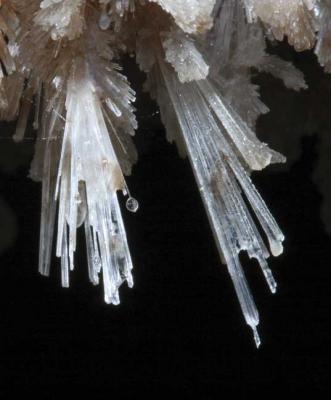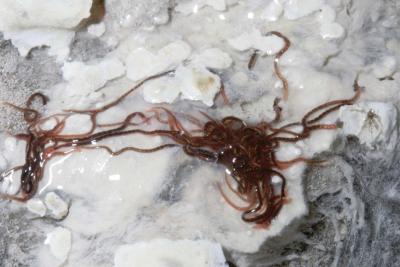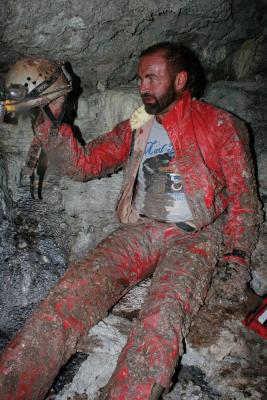New Find at Sulphur Cave
12/01/2009 01:00AM ● By Jennie Lay
by Jennie Lay
A smelly Steamboat curiosity yields an extraordinary scientific discovery.
SULPHUR CAVE has never been a big secret. Cavers' know it’s in downtown Steamboat Springs – a small, malodorous hole near the base of a travertine slope that is Howelsen Hill, Colorado’s oldest operating ski area. But at a mere 10,000 years young, it isn’t as old, pretty or big as other caves. It also has other things keeping it off most spelunkers’ radar. “The signs that say you could die in there are very persuasive,” says Rocky Mountain Caving editor Richard Rhinehart.
Then veteran caver Mike Frazier came to Steamboat in 2001 and changed everything. Climbing inside Sulphur Cave for a quick peek, Frazier spotted snotties, soft colonies of microorganisms that hang inside caves and resemble the gooey nose drippings for which they are named. Snotties are so globally rare (there are only two other known instances in Colorado, one in Mexico and one in Italy) that it raised scientific curiosity.

As well as microbe life, scientists also marvel at the cave's many formations, including gypsum crystals like these. Photograph Courtesy of Norman R.Thompson
In 2007 a team of scientists, cavers and photographers took on the task of exploring this local labyrinth. To date, the team has ventured inside four times using highly specialized gear to combat a toxic atmosphere that burns clothing (and skin) as it condenses and drips, and blackens pocketed pennies. This fall, the team learned that their pain has yielded an extraordinary scientific gain.
The expedition initially focused on the snotties, but the big discovery is worms. More specifically, scientists found squirmy clumps of red worms bearing rare bacteria, known as extremophiles, which may live on hydrogen sulfide. A fespecies like this live in hydrothermal vents along the Pacific’s mid-ocean ridge, but Sulphur Cave’s worms may turn out to be Earth’s first animals dependent on hydrogen sulfide ever discovered on land.

The cave's unique worms are believed to live on sulfur's chemical energy, similar to the way tube worms live without light at the bottom of the ocean. Photograph Courtesy of Norman R. Thompson
Imagine the scientists’ excitement at the worms’ simple accessibility: a dive to the bottom of the Pacific vs. a five-minute saunter inside Sulphur Cave. Sulphur Cave’s worms offer scientists a glimpse of what they anticipate finding on Mars or the moons of Saturn. “If we end up going and looking for life on other planets, those animals are probably going to be bacteria or bacteria-like and they’re probably going to be living in environments similar to this,” says Dr. Fred Luiszer, a geologist and speleologist with the University of Colorado in Boulder. “By studying those things here on Earth, it’s going to be easier for them to figure out where to look for life and what kind of equipment and instruments we’ll need.”
Making the discovery
Dr. Norman Pace, a distinguished professor at CU’s department of molecular, cellular and developmental biology, suspected the worms were biologically significant during a visit into the cave in 2008, when the team discovered them. He joined the expedition because of his interest in acid environments and hydrogen sulfide as a potential food source. “I’m looking at nelines of descent. I’m mapping the big tree of life,” says Dr. Pace, who was awarded a MacArthur Genius Grant in 2001 for his work in mapping biological diversity. Most of that diversity, he says, is microbial and often is found in “weird places” like Sulphur Cave.

Stalactites, stalagmites and columns can all be found inside Sulphur Cave. Photograph Courtesy of Norman R. Thompson.
A late summer 2009 visit into the Sulphur Cave didn’t disappoint. The worms were still there, clumping and squirming in the acidic water just as they were the previous year. Scientists removed a fefor sampling, but keeping them alive proved more difficult than they initially expected. “We set up an aerated aquarium and they immediately curled up and did a death roll and all their guts came spilling out,” says Dr. Hazel Barton, one of Dr. Pace’s protégées and star of the IMAX movie Journey Into Amazing Caves.
On a second attempt, with a salty medium to match the cave, the worms survived. The worms journeyed back to Dr. Barton’s Kentucky lab inside a cooler before being starved, given experimental doses of bubbling hydrogen suphide, dissected and inspected under a microscope. In mid-September the worms were sent out for DNA sequencing.Small worms, big news
One week later, DNA tests confirmed the team’s suspicions: Sulphur Cave worms are globally unique. “This could be one of the craziest things I’ve ever seen in my life,” Dr. Barton says. “What you’ve got nois the potential for an endangered species. This is the only habitat for it. The next closest thing is diving two miles to the bottom of the Pacific Ocean. It wouldn’t take much to wipe out the entire population. This is a world-class site.”
The next step is to demonstrate hoSulphur Cave’s worms get energy. Do they eat bacteria that metabolize hydrogen sulfide or, like the Pacific’s vent tubeworms, do the Sulphur Cave worms breathe in hydrogen sulfide and carbon dioxide and use internal microbes to transformthe gas into food, effectively breathing out sugar for the worm to live on. These scientific results will be revealed in a future journal article.

Mike Frazier, coated with chemical-energy-living microbe slime after a mapping foray (the slime contains sulfuric acid, which eats holes in clothing). Photograph Courtesy of Norman R. Thompson
In the meantime, Dr. Barton stresses the need to protect Sulphur Cave. That means something more substantial than the flimsy blue netting that currently surrounds the entrance more as a precaution for catching wayward skiers than for protecting these rare worms and their toxic environment. “One of the important things is to make sure not to change the environment there too much,” Dr. Luiszer says. “This could end up being a world-class cave for study. It’s an excellent place to do long-term study with really easy access.”
A virtual tour
The land around the steep entrance to Sulphur Cave is owned by the city, and hikers and skiers can peer into the cave’s upper room from the surface. Even the grasses and plants growing directly outside the entrance are poisonous. The knee-high plants are in the arrowgrass family and contain hydro-cyanic acid, which is highly poisonous to livestock.
The Sulphur Cave team has traveled as far into the cave as humanly possible. Inside, the temperature ranges from 50 to 55° Fahrenheit year-round. It has been extensively mapped, although the maps are not available to the public. Sulphur Cave’s total survey length is 180 feet.
The chamber you can see from the surface is big enough to walk around in. On the south wall, the surface spring runs in and joins up with a larger flow, where water is continuously de-gassing, making it toxic for humans. At the bottom, it’s swampy.
Getting inside is no picnic. Entering the cave without special manhole blowers and a gas analyzer could be fatal. Scientists use a high-tech ventilation system to pump out the gasses and wear respirators to neutralize the worst of the hydrogen sulfide (i.e., the stinky rotten-egg smell).
Dr. Luiszer is the expedition’s safety officer. He’s also taking air measurements that are critical to understanding the microbiology of the water and the worms. He constantly monitors the air quality because there are bursts of gas, not unlike a geyser, that make the environment go from breathable to deadly in seconds.
Last summer, Dr. Luiszer measured hydrogen sulfide levels at 325 parts per million. OSHA’s standard for maximum exposure over an eight-hour day is 10 parts per million.
He also found high concentrations of carbon dioxide, the same gas that was once responsible for the chugging sound at the spring for which Steamboat was named. (Railroad construction ruined that effect in 1908.) His measurements shoSulphur Cave’s air at 20.8 percent carbon dioxide – four times the level that will kill you.
Top that off with the “eefactor,” which can overshadothe cave’s beauty. It’s a claustrophobic’s nightmare with complete darkness, small crevices, running water, bugs and the infamous snotties. The mapping crecrawled into every corner and wedged themselves through tiny openings wearing PVC suits. They emerged “looking and smelling like about 10 people had thrown up on them,” recalls a fellocaver.
Team photographer Norman Thompson, a 30-year veteran caver who wrote the definitive book on cave photography, captured Sulphur Cave’s visceral beauty – like vermiculations and masses of biological life on the cave walls that resemble the intricate twists and folds of brain coral. His close-up shots of tiny ceiling gypsum crystals sholacy white structures that glitter like starbursts. Small white and yellostalactites and stalagmites cling to the ceiling and floor – a mix of sulfur and calcium carbonate.
What lurks inside
Dave Steinmann is the bug collector. He is a cave biologist and associate at the Denver Museum of Nature and Science who came to Sulphur Cave in search of nespecies. So far he has confirmed three: the hydrogen sulfide-eating worms and two species of springtail (six-legged jumping “snofleas” that are albino and eyeless and only a couple millimeters long). None has been named yet.
By all accounts, the worms trump the springtails. “The worms are blood red, like they’ve got hemoglobin,” Mr. Steinmann says, noting that the most unusual trait is their tendency to clump together in the stream water. The worms are one to two inches long, thin as pencil lead and undulate in water like soft corals in a reef. They seem to try to stay anchored, but do slink around like an earthworm, and they live in the “dark zone” at the back of Sulphur Cave and are sensitive to light. “When you shine a light on them they curl up and contract in a little ball like they’re trying to hide.”
The worms and their bacteria have evolved to the specific chemistry, bedrock composition and temperature inside Sulphur Cave. It’s not easy for these species to migrate out of their specific environment, which brings about an urgent need to protect Sulphur Cave and the adjacent spring. The Sulphur Cave Expedition hopes to see the cave gated for safety and long-term study – although it could take some creative thinking: Dr. Luiszer points out that there’s almost no metal you could put over that cave that will not eventually dissolve, including stainless steel.
“It’s such a tiny cave, it’s susceptible,” Mr. Steinmann says. “It’s really an isolated and sensitive environment. If there were an accident or a diesel spill on the ski area it would be a real tragedy.”
~ EDITOR’S NOTE: Warning! Sulphur Cave is an important site for scientific study. It’s extremely dangerous, with deadly concentrations of gas. Entry is life-threatening and prohibited.
Fun Factoids
Beta for the right-brained: Although the preferred spelling for sulfur is with an “f,” Steamboat’s Sulphur Cave has historically been spelled with a “ph” and remains so to this day.
What else lives in there? Spiders. Lots of them. Cave biologist Dave Steinmann describes webs strung all over the ceiling holding tiny spiders with bodies the size of BBs. He suspects that the webs help facilitate formation of the small, delicate gypsum crystals that hang like cloudy snowflakes from the ceiling. Among Sulphur Cave’s other troglophiles (the scientific term for anything that prefers living in a cave, vs. a troglobite, which only lives in a cave – like the worms), Mr. Steinmann has also discovered beetles, microscopic aquatic crustaceans that resemble clam shells and dipluras, albino soil-dwellers that bear antennae at the head and tail.
Exploration origins: According to experts, Sulphur Cave was the first documented cave in Colorado, with vacationing Englishman Thomas Jefferson Farnman documenting it in his 1843 travelogue, Travels in the Great Western Prairies, following his trip to the Oregon Territory. n
Tracking the history of Colorado’s first documented cave
Richard Rhinehart, the founding editor of Rocky Mountain Caving, is an avid cave historian. He is confident in his research that Sulphur Cave was the first documented cave in Colorado.
While Native America legends of spiritual influence surround the Sulphur Cave, a vacationing Englishman left that first written documentation. Thomas Jefferson Farnham wrote a travelogue called Travels in the Great Western Prairies that was published in 1843 in London following his trip to the Oregon Territory. En route, along the banks of the Little Bear River he notes, “We came upon a cave formed by the limestone and sulphur deposit of a small stream that burst from a hill hard by. The water had, by constant depositions, formed an elevated channel some five rods down the face of the hillside, at the termination of which it spread itself over a circular surface of one hundred and fifty or two hundred feet in circumference. In the centre of this, was an orifice, down which the water trickled into the cave below. As little of the cave could be seen from the ground above, myself and two others attempted to explore it. We found the roof hung with beautifully crystallized sulphur, and the bottom strewn with large quantities of the same material in a pulverized state. The odour was so offensive, however, that we were glad to retreat before we had formed a very perfect estimate of its extent and contents.” (sic.)
A few years later, in 1855, Sir George Gore apparently built some kind of a structure over the cave entrance that he used as a hunting camp during his legendary hunting expedition through Colorado. By the time James Crawford, Steamboat’s founder, arrive in 1875, the Gore camp was in ruins but Crawford later discussed his own explorations around the cave in interviews with the local newspapers.
By 1910, someone was selling sepia postcards with photographs of the Sulphur Cave. And the Nov. 21, 1913, Routt County Sentinel reported that two men made a “visit to the inner recesses of the noted sulphur cave and brought out fine specimens of stalactites, which they have on exhibition…The gentlemen were nearly overcome by the strong sulphuric odor while securing the specimens but expect to make another visit and secure a picture of the wonderous formation.”
The next bit of newsworthy Sulphur Cave excitement didn’t happen until Sept.15, 1962, when Rudy Musco, an Italian exchange student made a nearly disastrous solo expedition into the cave. The Sept. 27, 1962, Steamboat Pilot gives a blow-by-bloaccount of the expeditions that started with Mr. Musco’s primitive breathing apparatus and ended with his collapse and being dragged“strongly convulsive” from the cave with “eyes (that) were wild with a look that I can describe only as one registering extreme fear.” He escaped with his life and a pencil sketch of his brief exploration.




